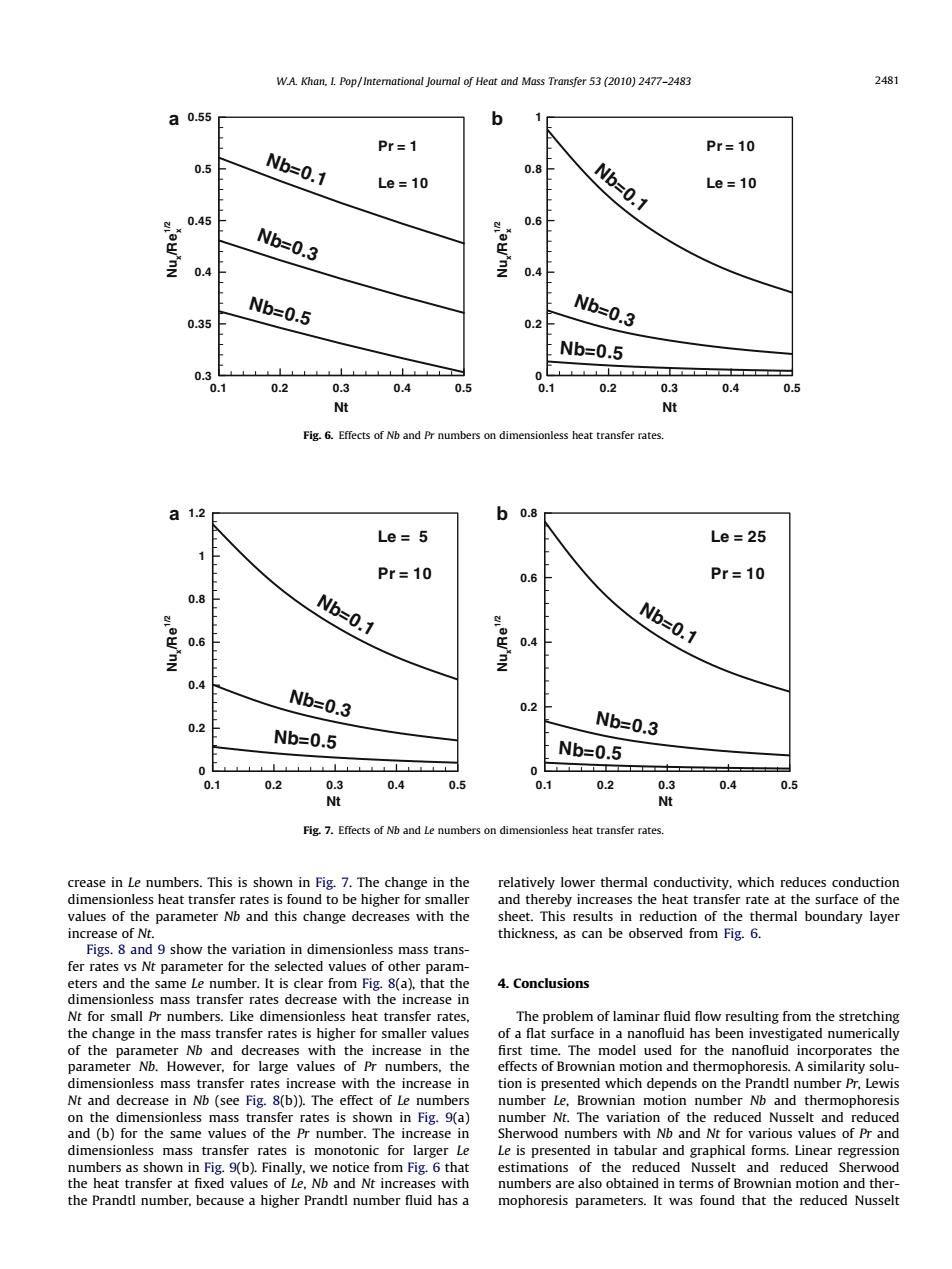正在加载图片...

WA Khan Pop/Heat nd Mas(010)477-43 2481 a0.55 b Nb=0.1 Pr=1 Pr=10 0.5 0.8 Le=10 Nb=0.1 Le-10 045 Nb=0.3 0.6 04 0.35 Nb=0.5 0.2 Nb=0.3 Nb=0.5 02 03 0.4 0.5 0.20.3 0.4 0.5 Nt Nt a12 b0.8 Le=5 Le=25 Pr=10 Pr=10 Nb=0.1 0.6 Nb=0.1 Nb=0.3 Nb=0.5 Nb=0.3 Nb=0.5 0.2 0.4 0.1 0.2 04 0.5 Fig 7.Effects of Nb and Le numbers on dim ionless heat transfer rates. relatively lower thermal conductivity.which reduces conduction This resultsin reduction of the thermal boundarylayer ed values of 4.Conclusions rates decn vith the increase i sfer rates is higher for smalle value for large values of Pr numbers.the ss6n防 is A similarity dimensionless massa tes is monotonic for Le of Le.Nb a nd Nt umbersare lso d in ter nian moti ion and ther ecause a higher Prandcrease in Le numbers. This is shown in Fig. 7. The change in the dimensionless heat transfer rates is found to be higher for smaller values of the parameter Nb and this change decreases with the increase of Nt. Figs. 8 and 9 show the variation in dimensionless mass transfer rates vs Nt parameter for the selected values of other parameters and the same Le number. It is clear from Fig. 8(a), that the dimensionless mass transfer rates decrease with the increase in Nt for small Pr numbers. Like dimensionless heat transfer rates, the change in the mass transfer rates is higher for smaller values of the parameter Nb and decreases with the increase in the parameter Nb. However, for large values of Pr numbers, the dimensionless mass transfer rates increase with the increase in Nt and decrease in Nb (see Fig. 8(b)). The effect of Le numbers on the dimensionless mass transfer rates is shown in Fig. 9(a) and (b) for the same values of the Pr number. The increase in dimensionless mass transfer rates is monotonic for larger Le numbers as shown in Fig. 9(b). Finally, we notice from Fig. 6 that the heat transfer at fixed values of Le, Nb and Nt increases with the Prandtl number, because a higher Prandtl number fluid has a relatively lower thermal conductivity, which reduces conduction and thereby increases the heat transfer rate at the surface of the sheet. This results in reduction of the thermal boundary layer thickness, as can be observed from Fig. 6. 4. Conclusions The problem of laminar fluid flow resulting from the stretching of a flat surface in a nanofluid has been investigated numerically first time. The model used for the nanofluid incorporates the effects of Brownian motion and thermophoresis. A similarity solution is presented which depends on the Prandtl number Pr, Lewis number Le, Brownian motion number Nb and thermophoresis number Nt. The variation of the reduced Nusselt and reduced Sherwood numbers with Nb and Nt for various values of Pr and Le is presented in tabular and graphical forms. Linear regression estimations of the reduced Nusselt and reduced Sherwood numbers are also obtained in terms of Brownian motion and thermophoresis parameters. It was found that the reduced Nusselt Nt Nux/Re1 x /2 0.1 0.2 0.3 0.4 0.5 0 0.2 0.4 0.6 0.8 1 Pr = 10 Le = 10 Nb=0.1 Nb=0.3 Nb=0.5 Nt Nux/Re1 x /2 0.1 0.2 0.3 0.4 0.5 0.3 0.35 0.4 0.45 0.5 0.55 Pr = 1 Le = 10 Nb=0.1 Nb=0.3 Nb=0.5 a b Fig. 6. Effects of Nb and Pr numbers on dimensionless heat transfer rates. Nt Nux/Re1/2 0.1 0.2 0.3 0.4 0.5 0 0.2 0.4 0.6 0.8 1 1.2 Le = 5 Pr = 10 Nb=0.1 Nb=0.3 Nb=0.5 Nt Nux/Re1/2 0.1 0.2 0.3 0.4 0.5 0 0.2 0.4 0.6 0.8 Le = 25 Pr = 10 Nb=0.1 Nb=0.3 Nb=0.5 a b Fig. 7. Effects of Nb and Le numbers on dimensionless heat transfer rates. W.A. Khan, I. Pop / International Journal of Heat and Mass Transfer 53 (2010) 2477–2483 2481